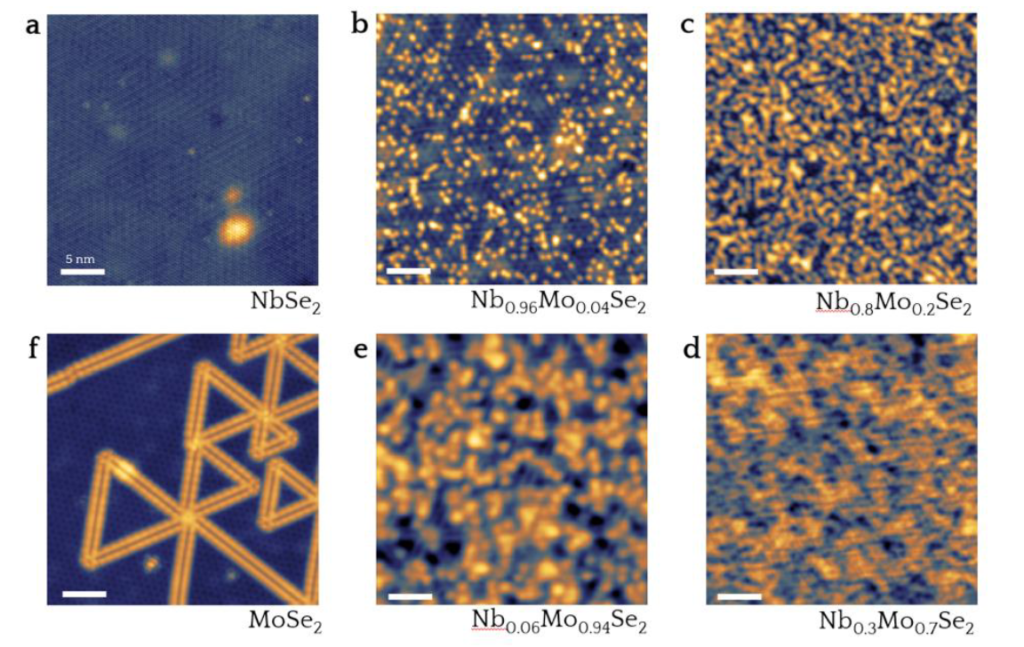Evolution of a 2D alloy throughout the metal to semiconductor transition
Transition metal dichalcogenides (TMDs) are layered compounds which can be thinned down to the single-layer limit. While mechanical exfoliation generates atomically thin TMD flakes possessing an area of a few square microns, chemical and physical methods provide high-quality monolayers on large-area substrates, which are suitable for actual technological applications.
TMDs are a class of van der Waals layered materials, an ideal playground for the investigation of exotic electronic phases in two dimensions due to greatly enhanced many-body interactions. One of the latest and most intriguing additions to the collection of nontrivial collective states in TMDs is a novel superconducting state dubbed “Ising superconductivity”, where spin-orbit coupling induced splitting of the singlet order parameter leads to a linear combination of momentum-separated singlet-triplet states, and an extraordinary protection against magnetic-field induced pair breaking. It has been proposed that impurity scattering plays a key role in Ising superconductivity, in particular, making the formally infinite in-plane critical field finite.
In transition metal dichalcogenides (TMD), the possibility of substituting one of the atomic elements by different species has greatly expanded the potential of this family of 2D materials. This route to obtain novel and stable TMD layers with tailored properties in the form of alloys (M1-δNδX2 or MX2(1-δ)Y2δ where M, N are transition metals and X, Y chalcogens, for binary alloys), has been recently demonstrated, and shows significant promise in electronic, optoelectronic and catalytic applications. Monolayer alloys that connect two MX2 materials with different phases (structural, electronic, magnetic, etc.) should enable one to manipulate these phase transitions where the chemical composition of the alloy serves as the tuning parameter. However, the synthesis of a particular TMD alloy is subject to the miscibility of the components and its thermodynamic stability.

Now, a team of researchers presents 1 an experimental and theoretical investigation of the aliovalent TMD alloy Nb1-δMoδSe2. The researchers investigate the atomic and electronic structure of this 2D alloy throughout the metal to semiconductor transition (monolayer NbSe2 to MoSe2), examining the evolution using low-temperature scanning tunnelling microscopy / spectroscopy .
The point is to explore the effect of electron doping on the monolayer NbSe2 and track its impact on the electronic bands. Apart from the fact that the bandgap evolution and the band shifts are monotonic with δ, two results seem the most relevant. First, the metal-semiconductor transition in this TMD alloy occurs for Nb concentrations of 25% (δ = 0.75), which enables a wide-range across which the band gap can be tuned up to a maximum band gap of 2.2 eV of monolayer MoSe2. Second, a nearly simultaneous disappearance of the charge density wave and superconductivity is also observed when the Mo concentration exceeds 15% (δ≥ 0.15), which highlights the robustness of these collective states against disorder.
Interestingly, superconducting critical temperature changes non-monotonically with doping. This contrasting behaviour in the normal and superconducting state is explained using first-principles calculations. The researchers show that Mo doping decreases the density of states at the Fermi level and the magnitude of pairbreaking spin fluctuations as a function of Mo content.
While some aspects of the evolution of electronic and superconducting properties are seemingly unexpected, and even counterintuitive, our first-principles calculations yield complete microscopic insight into these changes as a function of doping.
This work provides a general methodology to study a wide variety of disorder-driven 2D electronic phase transitions, which remain largely unexplored due to the lack of suitable platforms.
Author: César Tomé López is a science writer and the editor of Mapping Ignorance
Disclaimer: Parts of this article may have been copied verbatim or almost verbatim from the referenced research paper/s.
References
- Wen Wan, Darshana Wickramaratne, Paul Dreher, Rishav Harsh, I. I. Mazin, Miguel M. Ugeda (2022) Nontrivial Doping Evolution of Electronic Properties in Ising-Superconducting Advanced Materials doi: 10.1002/adma.202200492 ↩